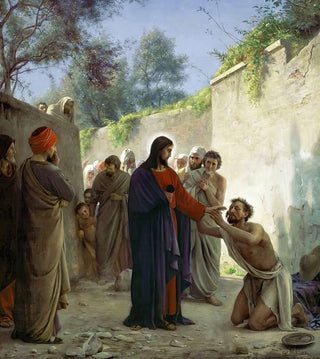Painting The Christ Heals the Blind - Carl Bloch | Art print


View from behind

Frame (optional)
In the vibrant universe of religious art, the artwork "The Christ Heals the Blind" by Carl Bloch stands as a true ode to compassion and light. This painting, created in the 19th century, transcends the simple biblical narrative to offer a profound immersion into the human experience of faith and healing. Through this iconic scene, Bloch invites us to contemplate not only the miracle performed by Christ but also the palpable emotions that animate the characters. The light emanating from this piece, both divine and human, creates an enveloping atmosphere, plunging us into a moment of intense spirituality.
Style and uniqueness of the artwork
Carl Bloch's style is characterized by an exceptional mastery of light and shadow, which gives his paintings a striking depth. In "The Christ Heals the Blind," the composition is carefully arranged, with each element thoughtfully chosen to reinforce the spiritual message of the work. The faces of the characters, imbued with emotional intensity, are rendered with such precision that they seem almost alive. The colors, both vivid and nuanced, emphasize the contrast between the darkness of the blind man and the radiant clarity of Christ, symbolizing the victory of faith over ignorance. This artwork stands out for its ability to capture the moment of a divine encounter, a moment where the sacred and the profane meet in an artistic expression of rare power.
The artist and his influence
Carl Bloch, a Danish painter of the 19th century, is often praised for his contribution to sacred art. Influenced by the Romantic movement, he committed himself to depicting biblical themes with a new sensitivity, seeking to establish an emotional connection between the viewer and the sacred stories. His work was marked by a particular attention to detail and a desire to make the spiritual experience accessible to all. Bloch established himself as a master in the art of visual storytelling, his works often commissioned for churches and religious institutions. His legacy endures, inspiring generations of artists to explore

Matte finish

View from behind

Frame (optional)
In the vibrant universe of religious art, the artwork "The Christ Heals the Blind" by Carl Bloch stands as a true ode to compassion and light. This painting, created in the 19th century, transcends the simple biblical narrative to offer a profound immersion into the human experience of faith and healing. Through this iconic scene, Bloch invites us to contemplate not only the miracle performed by Christ but also the palpable emotions that animate the characters. The light emanating from this piece, both divine and human, creates an enveloping atmosphere, plunging us into a moment of intense spirituality.
Style and uniqueness of the artwork
Carl Bloch's style is characterized by an exceptional mastery of light and shadow, which gives his paintings a striking depth. In "The Christ Heals the Blind," the composition is carefully arranged, with each element thoughtfully chosen to reinforce the spiritual message of the work. The faces of the characters, imbued with emotional intensity, are rendered with such precision that they seem almost alive. The colors, both vivid and nuanced, emphasize the contrast between the darkness of the blind man and the radiant clarity of Christ, symbolizing the victory of faith over ignorance. This artwork stands out for its ability to capture the moment of a divine encounter, a moment where the sacred and the profane meet in an artistic expression of rare power.
The artist and his influence
Carl Bloch, a Danish painter of the 19th century, is often praised for his contribution to sacred art. Influenced by the Romantic movement, he committed himself to depicting biblical themes with a new sensitivity, seeking to establish an emotional connection between the viewer and the sacred stories. His work was marked by a particular attention to detail and a desire to make the spiritual experience accessible to all. Bloch established himself as a master in the art of visual storytelling, his works often commissioned for churches and religious institutions. His legacy endures, inspiring generations of artists to explore
12,34 €






